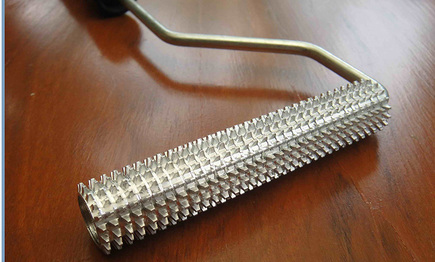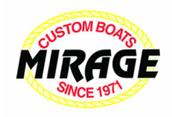Laying a Firm Foundation
|
In simplest terms, a fiberglass boat is nothing more than layers of small glass fibers held together by plastic resins. The fibers add strength, the resins provide the hardness. Of course, there's a lot more to the story, and a lot more to creating a fiberglass part that is strong and durable. One of the easiest fiberglass construction methods involves spraying a pre-mixed concoction of wet resin and individual glass strands into a mold. But this type of chopped-strand mat is also the weakest and least desirable form of lamination, and you won't find it in a Mirage boat.
|
Better results are achieved when glass fiber strands are spun into yarns then woven or knitted into cloth-like materials. These cloths are placed in a mold and saturated in resins that harden to create a rigid panel. The quality of this process is directly related to the amount of resin used to encapsulate the cloths. Too much resin results in a laminate that is brittle and has a lower strength-to-weight ratio. Too little resin and the laminate won't hold together. The best way to control this ratio isn't by machine, but by skilled hand-application of resins, followed by the removal of excess materials and any air bubbles created by the application. This process of “hand-laying” a boat is practiced by many of the world's best builders, but it takes a skilled craftsman to achieve optimum results and an ideal resin-to-glass ratio.
At Mirage, we not only employ highly-trained lamination specialists, we provide them with the select materials that ensure the finest possible results. We use only premium polyester and vinylester resins, which have superior bonding qualities, greater resistance to water absorption, and higher impact tolerances to reduce the frequency of stress fractures. Another key difference in our lamination process is the exclusive use of knitted biaxial cloths. Unlike woven cloths, in which bundles of fiberglass roving are woven together loosely in an over-under pattern, knitted fabrics are bundled and stitched together to create a flatter profile. This provides several advantages. The lower profile of the knitted fabric eliminates voids in the weave that trap excess resin, which adds weight and results in a more brittle laminate.
In addition, the individual strands of a woven cloth bend each time they are woven under and over each other. This makes the material vulnerable to a phenomenon known as crimping, which can reduce the overall stiffness of the laminate. Crimping occurs when woven strands are subjected to loads and attempt to straighten out. Each bend point in the weave creates a crimp, which will stretch and sometimes fracture. Because of their horizontal orientation, the strands of knitted fabrics are largely immune to crimping. Knitted fabrics also have a higher fabric count per square inch, which results in greater overall strength, and they retain that strength when conforming to an angled surface such as the edge of a bulkhead or reinforcing stringer. Overall, the use of knitted biaxial fabrics results in a stronger, lighter laminate, and that's why we insist on their use in all our boats.
At Mirage, we not only employ highly-trained lamination specialists, we provide them with the select materials that ensure the finest possible results. We use only premium polyester and vinylester resins, which have superior bonding qualities, greater resistance to water absorption, and higher impact tolerances to reduce the frequency of stress fractures. Another key difference in our lamination process is the exclusive use of knitted biaxial cloths. Unlike woven cloths, in which bundles of fiberglass roving are woven together loosely in an over-under pattern, knitted fabrics are bundled and stitched together to create a flatter profile. This provides several advantages. The lower profile of the knitted fabric eliminates voids in the weave that trap excess resin, which adds weight and results in a more brittle laminate.
In addition, the individual strands of a woven cloth bend each time they are woven under and over each other. This makes the material vulnerable to a phenomenon known as crimping, which can reduce the overall stiffness of the laminate. Crimping occurs when woven strands are subjected to loads and attempt to straighten out. Each bend point in the weave creates a crimp, which will stretch and sometimes fracture. Because of their horizontal orientation, the strands of knitted fabrics are largely immune to crimping. Knitted fabrics also have a higher fabric count per square inch, which results in greater overall strength, and they retain that strength when conforming to an angled surface such as the edge of a bulkhead or reinforcing stringer. Overall, the use of knitted biaxial fabrics results in a stronger, lighter laminate, and that's why we insist on their use in all our boats.


